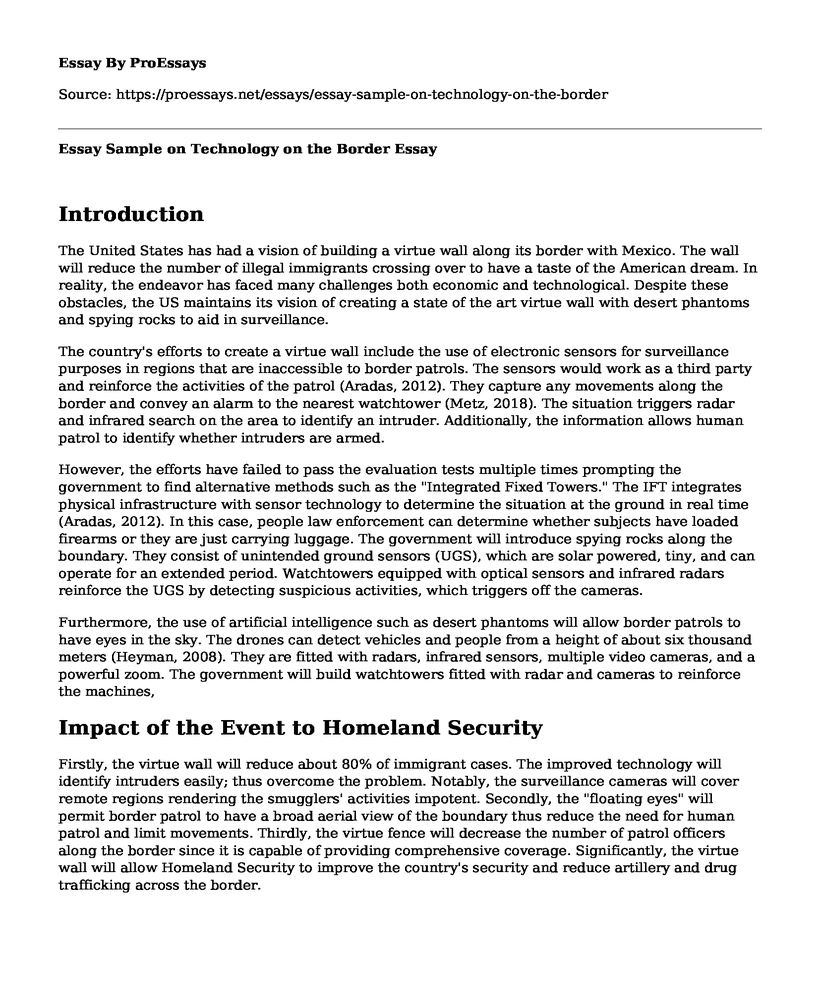Introduction
The United States has had a vision of building a virtue wall along its border with Mexico. The wall will reduce the number of illegal immigrants crossing over to have a taste of the American dream. In reality, the endeavor has faced many challenges both economic and technological. Despite these obstacles, the US maintains its vision of creating a state of the art virtue wall with desert phantoms and spying rocks to aid in surveillance.
The country's efforts to create a virtue wall include the use of electronic sensors for surveillance purposes in regions that are inaccessible to border patrols. The sensors would work as a third party and reinforce the activities of the patrol (Aradas, 2012). They capture any movements along the border and convey an alarm to the nearest watchtower (Metz, 2018). The situation triggers radar and infrared search on the area to identify an intruder. Additionally, the information allows human patrol to identify whether intruders are armed.
However, the efforts have failed to pass the evaluation tests multiple times prompting the government to find alternative methods such as the "Integrated Fixed Towers." The IFT integrates physical infrastructure with sensor technology to determine the situation at the ground in real time (Aradas, 2012). In this case, people law enforcement can determine whether subjects have loaded firearms or they are just carrying luggage. The government will introduce spying rocks along the boundary. They consist of unintended ground sensors (UGS), which are solar powered, tiny, and can operate for an extended period. Watchtowers equipped with optical sensors and infrared radars reinforce the UGS by detecting suspicious activities, which triggers off the cameras.
Furthermore, the use of artificial intelligence such as desert phantoms will allow border patrols to have eyes in the sky. The drones can detect vehicles and people from a height of about six thousand meters (Heyman, 2008). They are fitted with radars, infrared sensors, multiple video cameras, and a powerful zoom. The government will build watchtowers fitted with radar and cameras to reinforce the machines,
Impact of the Event to Homeland Security
Firstly, the virtue wall will reduce about 80% of immigrant cases. The improved technology will identify intruders easily; thus overcome the problem. Notably, the surveillance cameras will cover remote regions rendering the smugglers' activities impotent. Secondly, the "floating eyes" will permit border patrol to have a broad aerial view of the boundary thus reduce the need for human patrol and limit movements. Thirdly, the virtue fence will decrease the number of patrol officers along the border since it is capable of providing comprehensive coverage. Significantly, the virtue wall will allow Homeland Security to improve the country's security and reduce artillery and drug trafficking across the border.
Personal Reflection
I believe the introduction of the virtue wall is imperative to reduce the illegal immigration menace once and for all. Smugglers have capitalized on the patrols incompetence in surveilling all parts of the boundary. However, I think the drones will contribute much in eliminating the blind spots. On the other hand, the government should not delay the program due to high budget because it has lucrative long-term benefits. Moreover, the government should not reduce the number of border patrol officers since the technology is prone to failure.
Overall, the virtue fence will facilitate the Department of Homeland Security's efforts to secure the country. The integration of drones, surveillance towers, and UGS will reinforce human intelligence in combating illegal immigration. They will reduce illegal immigration mainly. Lastly, the government should fasten its speed towards the implementation of the project.
ReferencesAradas, A. (29 August 2012). US-Mexico border: Efforts to build a virtual wall. BBC. Retrieved from https://www.bbc.com/news/technology-19409682
Heyman, J. (2008). Constructing a Virtual Wall: Race and Citizenship in U.S.-Mexico Border Policing. Journal of the Southwest, 50(3), 305-333. Retrieved from http://www.jstor.org/stable/40170393
Metz, C. (18 September 2018). Parts of a 'virtual' border wall, built with the tech behind driverless cars. The New York Times. Retrieve from https://www.nytimes.com/2018/09/18/technology/trump-border-wall-lidar.html
Cite this page
Essay Sample on Technology on the Border. (2022, Oct 24). Retrieved from https://proessays.net/essays/essay-sample-on-technology-on-the-border
If you are the original author of this essay and no longer wish to have it published on the ProEssays website, please click below to request its removal:
- Jemaah Islamiyah in the Philippines Terrorist Group Essay
- Evidence-Based Obesity Prevention in Childhood Essay Example
- Research Paper Example on Robotics
- Methamphetamine: An Illegal Drug Used For Recreational & Medical Purposes - Research Paper
- Essay Example on US Security Concerns Rise After Terror Attacks
- Paper Sample on Marginalized Populations: Mental Health, Drug Addiction, and LGBT Youth
- Should Euthanasia Be Legalized? An Argumentative Essay Example







